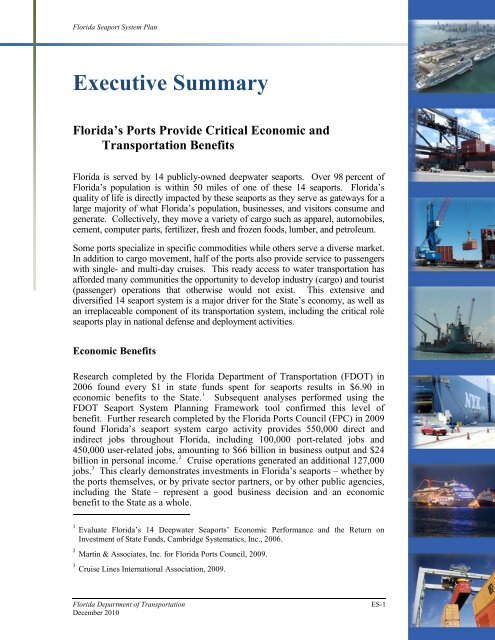Florida Seaport System Plan - SeaCIP
Florida Seaport System Plan - SeaCIP
Florida Seaport System Plan - SeaCIP
You also want an ePaper? Increase the reach of your titles
YUMPU automatically turns print PDFs into web optimized ePapers that Google loves.
<strong>Florida</strong> <strong>Seaport</strong> <strong>System</strong> <strong>Plan</strong><br />
Executive Summary<br />
<strong>Florida</strong>’s Ports Provide Critical Economic and<br />
Transportation Benefits<br />
<strong>Florida</strong> is served by 14 publicly-owned deepwater seaports. Over 98 percent of<br />
<strong>Florida</strong>’s population is within 50 miles of one of these 14 seaports. <strong>Florida</strong>’s<br />
quality of life is directly impacted by these seaports as they serve as gateways for a<br />
large majority of what <strong>Florida</strong>’s population, businesses, and visitors consume and<br />
generate. Collectively, they move a variety of cargo such as apparel, automobiles,<br />
cement, computer parts, fertilizer, fresh and frozen foods, lumber, and petroleum.<br />
Some ports specialize in specific commodities while others serve a diverse market.<br />
In addition to cargo movement, half of the ports also provide service to passengers<br />
with single- and multi-day cruises. This ready access to water transportation has<br />
afforded many communities the opportunity to develop industry (cargo) and tourist<br />
(passenger) operations that otherwise would not exist. This extensive and<br />
diversified 14 seaport system is a major driver for the State’s economy, as well as<br />
an irreplaceable component of its transportation system, including the critical role<br />
seaports play in national defense and deployment activities.<br />
Economic Benefits<br />
Research completed by the <strong>Florida</strong> Department of Transportation (FDOT) in<br />
2006 found every $1 in state funds spent for seaports results in $6.90 in<br />
economic benefits to the State. 1<br />
Subsequent analyses performed using the<br />
FDOT <strong>Seaport</strong> <strong>System</strong> <strong>Plan</strong>ning Framework tool confirmed this level of<br />
benefit. Further research completed by the <strong>Florida</strong> Ports Council (FPC) in 2009<br />
found <strong>Florida</strong>’s seaport system cargo activity provides 550,000 direct and<br />
indirect jobs throughout <strong>Florida</strong>, including 100,000 port-related jobs and<br />
450,000 user-related jobs, amounting to $66 billion in business output and $24<br />
billion in personal income. 2 Cruise operations generated an additional 127,000<br />
jobs. 3<br />
This clearly demonstrates investments in <strong>Florida</strong>’s seaports – whether by<br />
the ports themselves, or by private sector partners, or by other public agencies,<br />
including the State – represent a good business decision and an economic<br />
benefit to the State as a whole.<br />
1<br />
Evaluate <strong>Florida</strong>’s 14 Deepwater <strong>Seaport</strong>s’ Economic Performance and the Return on<br />
Investment of State Funds, Cambridge <strong>System</strong>atics, Inc., 2006.<br />
2<br />
Martin & Associates, Inc. for <strong>Florida</strong> Ports Council, 2009.<br />
3<br />
Cruise Lines International Association, 2009.<br />
<strong>Florida</strong> Department of Transportation<br />
December 2010<br />
ES-1
















